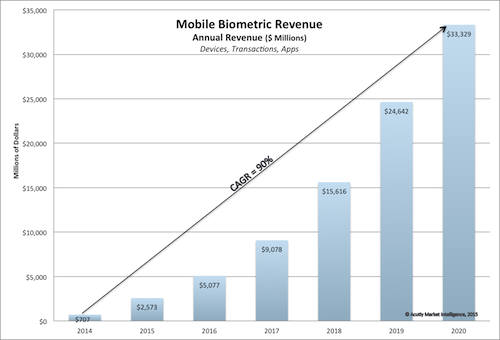It is expected that biometrics modules will be put into all smart mobile devices, such as smartphones, tablet PCs and wearable devices, by 2020, and the related market will grow by 90% a year and be worth $33.3 billion (about KRW36 trillion).

A market research firm AMI (Acuity Market Intelligence) made this forecast in ‘The Global Biometrics and Mobility Report’ it recently published.
With ‘FinTech,’ the convergence between finance and information technology (IT), drawing a great deal of public attention, biometric information recognition technologies, such as fingerprint recognition and iris recognition, are spotlighted as next-generation security authentication technologies that will replace digital certificates. As parts technologies are advancing, e.g. improved sensor recognition rates and smaller modules, and they are forecast to be applied to next-generation smartphones and wearable devices, related markets and downstream industries are expected to grow.
“Biometrics is the recognition module most suitable for smart mobile devices that we hold in our hands in most of our waking hours,” said Maxine Most, CEO of AMI. “Biometrics will be used in all smart mobile devices in 2020 by default.”
Domestic electronic parts makers are taking a hard look at biometric as a new business. In fingerprint recognition, whose market is already formed, related specialists and touch screen panel (TSP) makers are making efforts to commercialize the technology, and when it comes to iris recognition, camera module makers are capitalizing on existing technologies to open the market.
CrucialTec has already established itself in the market with its fingerprint recognition module. Possessed of the area method, i.e. reading fingerprints with a single touch, and the swipe method, i.e. swiping the fingerprint for recognition, this company is increasing supplies especially in the Chinese market. The cumulative supply quantity amounts to 8.5 million units. Last year its fingerprint module was applied to the premium smartphones of Huawei and Oppo, and it was favorably received.
CrucialTec joined hands with Danal, a payment service provider, to establish a comprehensive biometrics solution company Bio Pay and is preparing various biometric information-based authentication solutions, such as fingerprint recognition, iris recognition and vein recognition .
A TSP specialist Trais is also working hard to develop a fingerprint recognition solution. Recently it developed the smart payment authentication technology ‘T-SEC,’ which makes enables mobile payment with fingerprint recognition alone. This technology makes it possible to recognize fingerprints only with the display without any separate module like the ‘Home Button.’ Trais was named the lead manager of the Ministry of Trade, Industry & Energy’s fingerprint recognition technology development support project last year, and has been carrying out the project in the form of a joint research among the industry, universities and research institute.
Unlike fingerprint recognition that was applied to major smartphone product groups, iris recognition is just about to be introduced. Before application to the finished product, it is being optimized in terms of recognition distance and accuracy. Samsung Electronics also showed interest in iris recognition back in 2012 by applying for patents related to iris recognition, but whether SEC will apply it to its products has not been confirmed.
Camera module specialists, such as POWERLOGICS and Haesung Optics, are developing cameras to which the iris recognition technology is applied, but the general consensus is that it will take more time to commercialize this technology than fingerprint recognition. POWERLOGICS developed an iris recognition camera module for use in smartphones last year, and is conducting mobile optimization in preparation for mass-production.
“Fingerprint recognition went past the review stage, and began to be applied to smartphones in earnest, but iris recognition technology is still premature,” said a part industry insider. “As the biometrics market has great potential, however, it is important to acquire the technologies for core parts like sensors.”